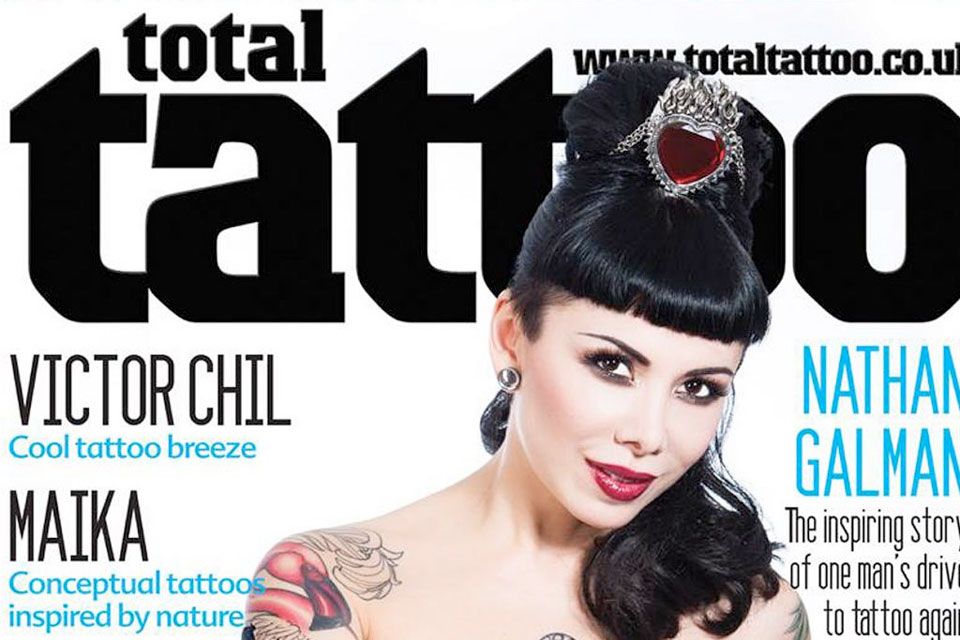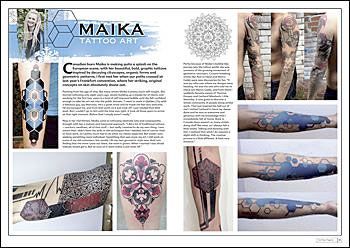mai 2015 / Maïka Zayagata
Entrevue magazine Total Tattoo, mai 2015

Canadian born Maika is making quite a splash on the European scene, with her beautiful, bold, graphic tattoos inspired by decaying cityscapes, organic forms and geometric patterns. I first met her when our paths crossed at last year’s Frankfurt convention, where her striking, original concepts on skin absolutely shone out.
Painting from the age of nine, like many artists Maika is pretty much self-taught. She started tattooing only eight years ago, slowly building up a steady list of clients and working for the first four years in a kind of self-imposed bubble until she felt confident enough to take her art out into the public domain. “I went to work in Quebec City with a fabulous guy, Jay Marceau. He’s a great artist and he made me feel very welcome. He encouraged me, and from that point on it just took off. I just needed that little push. But I couldn’t go to him until the time was right. It took all those years to arrive at that right moment. Before that I simply wasn’t ready.”
Now in her mid thirties, Maika came to tattooing relatively late and consequently brought with her a mature and measured approach. “I did a lot of traditional tattoos – anchors, swallows, all of that stuff – but really I wanted to do my own thing. I was aware that I didn’t have the skills or the techniques that I needed; and of course I had to have work, so I pretty much had to do what my clients expected. But inside I was seeking something more individual. Something that was more my art. I still work on some of my old customers, but mostly I do my own geometric style now. And I am finding that the more I post out there, the more it grows. When I started I was afraid nobody would get it. But as soon as it went online it just took off.”
Partly because of Maika’s bubble-like journey into the tattoo world, she was unaware of the growing movement of geometric tattooers. Ground-breaking artists like Xed Le Head and Marco Galdo were new discoveries for her. “It was Jay who saw where my designs were heading. He was the one who told me to check out Marco Galdo, and from there I suddenly became aware of Thomas Hooper and Gerhard Wiesbeck, Little Swastika. It was great to discover a whole community of people doing similar work. That just inspired the hell out of me! I visited Gerhard to have my sleeve done and he was so awesome and generous with his knowledge that I immediately felt at home. Back in Canada there weren’t so many artists doing stuff like mine, so I always felt a little lonely. Talking and drawing with him, I realised that what I do requires a slight shift in thinking. The creative process is a little different. It feels very intuitive.”
Maika continues, “I take inspiration from lots of areas outside of tattooing. I love broken-down landscapes. They can be viewed in a very graphic way, full of geometric shapes. Abandoned spaces have a derelict beauty all their own. I guess I would describe my style of work as ‘industrial geometry’ or ‘organic geometry’. Sometimes I like to contrast my geometric patterns with the more organic flow of the body. They complement each other.”
What makes Maika’s work stand out for me is the fundamental structure of her designs. The precision of the angles, the perfection of the lines, the placement of the elements… all layered to create a finished piece that seems to be the product of a skill set completely different to that required for traditional tattooing. Maika believes this approach derives from her early education in 3D animation. “Working with objects in three-dimensional space, and surfaces on different planes, has always fascinated me. I love using Photoshop to layer things up. And working with straight lines and evenly-spaced dots really helps to keep me focussed. If I’m working with traditional tattoo imagery my mind kind of wanders and I don’t like that feeling. I want to be here and now. The style of work that I do requires me to be super-focussed and there is no room for me to drift off.”
We went on to discuss the necessary balance between striving for absolute mathematical perfection and accepting a visually satisfying representation of mathematical perfection. “There comes a point where you have to let go of the pursuit of perfection,” Maika explains. “You have to understand that this is a body, and sometimes you have to adapt a design to suit its form. That’s where the intuitive part of the process comes in. If I put on a stencil and I can see where it may not be so perfect, then I can adapt it to make it work. It’s hard to explain, but with experience you learn to trust your gut instincts and for me it always works.”
With most tattoo styles there is a historical reference, a correct way to proceed, but Maika’s style has no past and is therefore breaking new ground all the time. I wondered if this created a pressure to be pushing forward with every single tattoo. “Actually, that’s exactly what drives me!” Maika tells me. “I have a huge respect for the Japanese style, and traditional tattooists, but my work comes from inside me. I came to tattooing later in my life and I never read lots about it. I don’t follow any preset rules or ideologies. How do I come to be doing art in this way? Well, it’s just that my life path – and the things that I love – have brought me to it. I guess I’m creating the story as I go. At first I just stumbled along, then slowly the way became clearer. The work I do has no boundaries; there is no right or wrong, as you would get with other styles. It’s not contained. I can bring every new thing that inspires me to the table and create my own original art. I am fortunate that people are now beginning to recognise my work and come to me specifically for what I do.”
For Maika, the relationship with her customer is a very important part of the creative process. “I always want the input of the client,” she says. “I am only as good as my client is!” And she enjoys working within any limitations imposed by her client. “Sometimes if there are restrictions on what I can do, I either find a way to make it work or – if I hit a wall – we may try a completely different route.”
Maika’s work is a combination of all the artistic influences that have shaped her throughout her life. Her tattoos incorporate graphic elements, dot work, mandalas and sacred geometry, blended with her own unique industrial and organic aesthetic. I asked Maika what ‘sacred’ meant to her, since it’s a word that has so many different meanings for different people. Her answer was illuminating. “For me, what’s sacred is that you find the same repeated patterns and shapes in everything in life – in nature, in our bodies, in our DNA. It’s the connection between all things.”
When she’s not working, Maika likes to be away from the world of ink. She’s passionate about her tattooing of course, but she also has many other interests and understands the importance of allowing herself time to relax, absorb new inspiration and avoid burning out. “Most of my friends don’t have tattoos, so we have conversations about other stuff. I need that when I’m not working, in order to go back revitalised.” She’s excited about what the future might hold. “I am loving the travelling, and I’m working at as many conventions as possible. I want to work with all the artists I admire, people like Ivan Hack (Russia), Alex Arnautov (Ukraine), Nazareno Tubaro (Argentina), Kenji Alucky from Japan and many others. I am currently based at a studio in Montreal called Tatouage Royal, with some great guys, and I don’t see myself opening my own studio in the short term. But long term, who knows what will happen.”
As our interview draws to a close, Maika recalls her crucial encounter with Jay Marceau in Quebec City that started everything off. “He will never really know how important his help was. When I met him, something clicked. My life changed. It was like he gave me the permission. I was ready, but I needed his push. Now I feel like I am just at the beginning of my career!”
